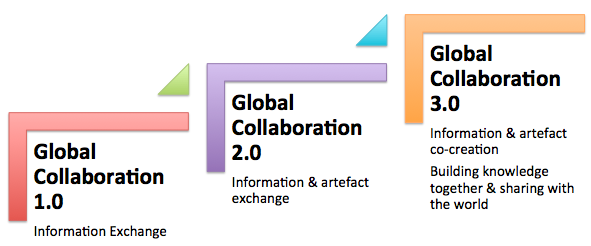Global collaboration
True global collaboration in the classroom needs a shift in teaching that allows teachers and students to 'flatten' the learning experience to bring the outside world in and put themselves out there – to build bridges for global empathy and create workable structures where all participants can learn with and not just from each other.
(Lindsay, 2014)
Collaboration is just as possible virtually as it is face-to-face. It is a higher order thinking and problem solving skill. When global collaboration is implemented across classrooms and across countries it can become a powerful tool for development and knowledge building.
Why global collaboration?
Effective global collaborators transcend time and space to connect, learn and create. The ‘flat’ or connected classroom is one that ‘...connects and engages with multiple audiences, resources and tools to create authentic, collaborative learning outcomes’ (Lindsay & Davis, 2012, p. 4).
Some assumptions about global collaboration:
- It is imperative for 21st Century learning
- It is one of the major reasons for using mobile and ubiquitous digital technologies
- It does support global awareness and competence and intercultural understanding – and we believe this is a GOOD thing, so good in fact that…
- It will change the world – it already has for the many teachers and students who have taken the opportunity to connect and collaborate
Global collaboration supports:
- Global competency – The cross-cultural skills and understanding needed to communicate outside one’s environment and to act on issues of regional and global significance.
- International mindedness and cultural awareness – Intercultural differences become intercultural understandings and break down stereotypes, cultural superiority and socio-economic dominance
- Cultural awareness – Working with others in the world virtually provides new understandings
- Glocalisation – Accepting differences and applying to the local context without homogenisation. The goal is not for one culture to emerge but to find differences as well as commonalities
Global collaboration in a digital world
Emerging technologies – including Web 2.0 tools – allow us to connect, communicate and collaborate with others beyond our immediate vicinity in a variety of exciting ways. Global collaboration is beyond merely integrating technology. It is a disruptive innovation and includes a new ‘category’ of tools and learning habits that support 21C skills and global collaborative objectives. Collaboration starts with reliable and responsible contribution – without that there can be no collaboration. Visible contribution online is one of the most difficult objectives for educators and students to grasp, and yet in a traditional classroom this is one of the most obvious to observe and record.
Schools and teachers face many challenges to starting global collaboration at the classroom level. It does take planning and often negotiation within a learning environment. Here are some typical challenges:
- Technology infrastructure and access to Web 2.0
- Global digital citizenship skills
- A rigid curriculum that does not allow new learning modes
- Teachers who have no idea where to start…
- The non-contributor or ‘lurker’, the ‘non-responder’
- Language disconnects
- Cultural taboos and disconnects
- Poor techno-personal skills
- The culture of learning – social vs educational
- Copyright and plagiarism
- Calendar and time zone factors
Evolution of global collaboration
The concept and practice of global collaboration in the classroom has changed since the development of the Internet. The evolution of tools and Internet speeds, combined with new curriculum objectives allows us to build a picture of different possibilities.
Each of these ‘levels' of collaboration are viable and in practice today and each can be transformational for learning in their own way. Global collaboration 1.0 and 2.0 involve essential connections and information exchanges leading to creation of artefacts by individual classrooms followed by some sharing of these artefacts. One important goal is for educators to design global collaboration 3.0 experiences as part of whole school global learning objectives. This level of course needs a stronger connection to the Internet and better bandwidth to support the learning objectives.
Global collaboration 3.0
- Engaged, connected teachers who know how to communicate using Web 2.0 and other online tools
- Carefully planned and designed projects that are implemented with a view to effectively join classrooms together to enhance learning
- Common assessment objectives
- High expectations and requirements for connectivity and collaboration on teachers and students
- Extended community partners who provide new knowledge, skills and resources for the learning community
- Use of multimedia to pitch ideas to solve real-world problems
- Teacher or student initiated themes, student-centred learning
 © 2012 Julie Lindsay & Vicki Davis
© 2012 Julie Lindsay & Vicki Davis